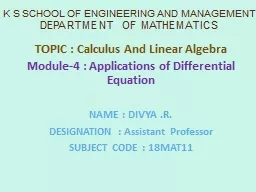

DEPARTMENT OF MATHEMATICS TOPIC Calculus And Linear Algebra Module4 Applications of Differential Equation NAME DIVYA R DESIGNATION Assistant Professor SUBJECT CODE 18MAT11 ID: 913824
Download Presentation The PPT/PDF document "K S SCHOOL OF ENGINEERING AND MANAGEMENT" is the property of its rightful owner. Permission is granted to download and print the materials on this web site for personal, non-commercial use only, and to display it on your personal computer provided you do not modify the materials and that you retain all copyright notices contained in the materials. By downloading content from our website, you accept the terms of this agreement.
Slide1
K S SCHOOL OF ENGINEERING AND MANAGEMENTDEPARTMENT OF MATHEMATICS
TOPIC :
Calculus And Linear
Algebra
Module-4 : Applications of Differential
Equation
NAME :
DIVYA .R
.
DESIGNATION :
Assistant
Professor
SUBJECT CODE : 18MAT11
Slide21.Newton’s Law of Cooling
2.LCR circuits
3.Problems on beams
4.Orthogonal Trajectories
Slide3Differential EquationExact Differential Equations: The differential equation M(x , y) dx + N(x , y)
dy
=0 to be an exact equation is
M/ y
=
N/ x
Further the solution of the exact equation is given by
M
dx
+ ò
N
(
y
)
dy
=
c
We integrate M(
x,y
)
w.r.t
x keeping y fixed and N(y) indicate the terms in N does not contain x
Slide4Application : Newton's Law of CoolingIt is a model that describes, mathematically, the change in temperature of an object in a given environment. The law states that the rate of change (in time) of the temperature is proportional to the difference between the temperature T of the object and the temperature Te of the environment surrounding the object.
d T / d t = - k (T - Te)
Let x = T – Te so that
dx
/
dt
=
dT
/
dt
Using the above change of variable, the above differential equation becomes
d x / d t = - k x
The solution to the above differential equation is given by
x = A e
- k t
Slide5substitute x by T - Te T - Te = A e - k t
Assume that at t = 0 the temperature T = To
To
- Te = A e
0
which gives A = To - Te
The final expression for T(t)
i
given by
T(t) = Te + (To - Te)e
- k t
This last expression shows how the temperature T of the object changes with time.
Slide6Real life examplesA coffee of 98 degree centigrade will take 30 minutes to come down to 45 degree centigrade in a room of temperature 30 degree centigradeA dosa
tava
will take at
teast
20 minutes to come down from 240 degree centigrade to 80 degree centigrade so that we can put it in wash basin.
Slide7Orthogonal Trajectories(OT)Trajectory: A curve which cuts every member of a given family of curves according to some definite law .Orthogonal Trajectory: A curve which cuts every member of a given family of curves at right angles .
Slide8ExamplesOrthogonal trajecteries for concentric circles is family of stright lines passing through originOrthogonal trajecteries for cardioids R=a(1+cos t) is r=a(1+sint)
Slide9Working rule to find the equation of OT in Cartesian formCartesian curves f(x,y,c)=0 1.Differentiate and eliminate the arbitrary constant c and the resulting equation if f(
x,y,dy
/
dx
)=0
2.Replace
dy
/
dx
by –
dx
/
dy
3. The diff equation of the form f(
x,y,-dx
/
dy
)=0
4.Solve the diff. equation to get the required O.T
Slide10Working rule to find the equation of OT in Polar formPolar curves f(r,,c)=01.Diff and eliminate the arbitrary constant c and the resulting equation if f(
r,
,
dr
/d
)=0
2.Replace
dr
/d
by – r2d
/
dr
3.
The diff equation of the form f(r,
,
–
r2d
/
dr
)=0
4.Solve the diff. equation to get the required O.T
Slide11https://nptel.ac.in/courses/111/106/111106100/This NPTEL video link contains differential equations of first order and higher order
with applications.
THANK YOU